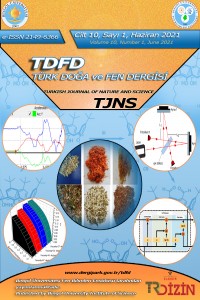Üç Scorzonera L. Taksonunun Toprak Üstü ve Kök Kısımlarının Yağ Asidi Profillerinin Değerlendirilmesi
Abstract
Scorzonera cinsi, çok sayıda doğal biyoaktif bileşiğin kaynağı olarak bilinir. Bu türlerin bazıları Asya ve Avrupa'da sebze, baharat ve tatlandırıcılar olarak kullanılmaktadır. Mevcut çalışmada, Scorzonera cinsine ait üç türün, toprak üstü ve kök kısımlarına ait yağların, yeni bir yağ asiti kaynağı olarak potansiyel kullanımları için gaz kromatografi cihazıyla analiz edilmiştir. Bu kısımların yağ asidi bileşimleri SFA (doymuş yağ asidi) için% 42.99-80.40, MUFA (tekli doymamış yağ asidi) için% 4.05-30.51, PUFA (çoklu doymamış yağ asidi) için% 15.43-32.68 olarak tespit edilmiştir. Toprak üstü ve kök kısımlarının yağ asidi profilleri incelendiğinde, SFA içeriği en yüksek olan bitkiler sırasıyla, S.tomentosa ve S. hispanica'dır. MUFA için en yüksek yüzde S. tomentosa bitkisinin toprak üstü ve kök kısmında gözlenmiştir. PUFA oranı en yüksek olan örnek ise S. hieraciifolia'nın toprak üstü ve S. tomentosa’nın kök kısmı olduğu görülmüştür. Çalışmamızda kullanılan türlerin SFA içeriklerinin MUFA ve PUFA’dan daha yüksek olduğu görülmüştür
References
- 1. Kaurinovic B, Popovic M, Vlaisavljevic S, Trivic S. Antioxidant capacity of Ocimum basilicum L. and Origanum vulgare L. extracts. Molecules. 2011;16(9):7401-14.
- 2. Mena P, Gironés-Vilaplana A, Martí N, García-Viguera C. Pomegranate varietal wines: Phytochemical composition and quality parameters. Food chemistry. 2012;133(1):108-15.
- 3. Xiao L, Mjøs SA, Haugsgjerd BO. Efficiencies of three common lipid extraction methods evaluated by calculating mass balances of the fatty acids. Journal of Food Composition and analysis. 2012;25(2):198-207.
- 4. Chow CK. Fatty acids in foods and their health implications: CRC press; 2007.
- 5. Kumari P, Reddy C, Jha B. Comparative evaluation and selection of a method for lipid and fatty acid extraction from macroalgae. Analytical biochemistry. 2011;415(2):134-44.
- 6. Vickers NJ. Animal communication: when i’m calling you, will you answer too? Current biology. 2017;27(14):R713-R5.
- 7. Zyriax BC, Windler E. Dietary fat in the prevention of cardiovascular disease—a review. European Journal of Lipid Science and Technology. 2000;102(5):355-65.
- 8. Anese M, Bot F, Panozzo A, Mirolo G, Lippe G. Effect of ultrasound treatment, oil addition and storage time on lycopene stability and in vitro bioaccessibility of tomato pulp. Food Chemistry. 2015;172:685-91.
- 9. Ramadan MF, Sharanabasappa G, Seetharam Y, Seshagiri M, Moersel J-T. Characterisation of fatty acids and bioactive compounds of kachnar (Bauhinia purpurea L.) seed oil. Food chemistry. 2006;98(2):359-65.
- 10. Sarı A, Şahin H, Özsoy N, Çelik BÖ. Phenolic compounds and in vitro antioxidant, anti-inflammatory, antimicrobial activities of Scorzonera hieraciifolia Hayek roots. South African Journal of Botany. 2019;125:116-9.
- 11. Erden Y, Kırbağ S, Yılmaz Ö. Phytochemical composition and antioxidant activity of some Scorzonera species. Proceedings of the National Academy of Sciences, India Section B: Biological Sciences. 2013;83(2):271-6.
- 12. Akkol EK, Šmejkal K, Kurtul E, Ilhan M, Güragac FT, İşcan GS, et al. Inhibitory activity of Scorzonera latifolia and its components on enzymes connected with healing process. Journal of ethnopharmacology. 2019;245:112168.
- 13. Sarı A, Özbek B, Özgökçe F. Antimicrobial activities of two Scorzonera species growing in Turkey. Asian Journal of Chemistry. 2009;21(6):4785-8.
- 14. Zengin G, Guler GO, Cakmak YS, Aktumsek A. Antioxidant capacity and fatty acid profile of Centaurea kotschyi (Boiss. & Heldr.) Hayek var. persica (Boiss.) Wagenitz from Turkey. Grasas y aceites. 2011;62(1):90-5.
- 15. Zengin G, Aktumsek A, Zengin G, Aktumsek A, Girón-Calle J, Vioque J, et al. Nutritional quality of the seed oil in thirteen Asphodeline species (Xanthorrhoeaceae) from Turkey. 2016.
- 16. Granica S, Lohwasser U, Jöhrer K, Zidorn C. Qualitative and quantitative analyses of secondary metabolites in aerial and subaerial of Scorzonera hispanica L.(black salsify). Food Chemistry. 2015;173:321-31.
- 17. Dall'Acqua S, Ak G, Sut S, Zengin G, Yıldıztugay E, Mahomoodally MF, et al. Comprehensive bioactivity and chemical characterization of the endemic plant Scorzonera hieraciifolia Hayek extracts: A promising source of bioactive compounds. Food Research International. 2020:109371.
- 18. Sarı A, Zidorn C, Ellmerer EP, Özgökçe F, Ongania KH, Stuppner H. Phenolic compounds from Scorzonera tomentosa L. Helvetica Chimica Acta. 2007;90(2):311-7.
- 19. Milella L, Bader A, De Tommasi N, Russo D, Braca A. Antioxidant and free radical-scavenging activity of constituents from two Scorzonera species. Food Chemistry. 2014;160:298-304.
- 20. Sutar I, Bahadir Acikara O, Saltan Citoglu G, Keles H, Ergene B, Kupeli Akkol E. In vivo and in vitro evaluation of the therapeutic potential of some Turkish Scorzonera species as wound healing agent. Current pharmaceutical design. 2012;18(10):1421-33.
- 21. Ayromlou A, Masoudi S, Mirzaie A. Chemical composition, antioxidant, antibacterial, and anticancer activities of scorzonera calyculata boiss. and centaurea irritans wagenitz. Extracts, endemic to iran. Journal of Reports in Pharmaceutical Sciences. 2020;9(1):118.
- 22. Nasseri MA, Bigy SS, Allahresani A, Malekaneh M. Assessment of antioxidant activity, chemical characterization and evaluation of fatty acid compositions of Scorzonera paradoxa Fisch and CA Mey. Jundishapur Journal of Natural Pharmaceutical Products. 2015;10(4):e19781.
Details
| Primary Language | Turkish |
|---|---|
| Journal Section | Articles |
| Authors | |
| Publication Date | June 25, 2021 |
| Published in Issue | Year 2021 Volume: 10 Issue: 1 |
Cite
This work is licensed under the Creative Commons Attribution-Non-Commercial-Non-Derivable 4.0 International License.

